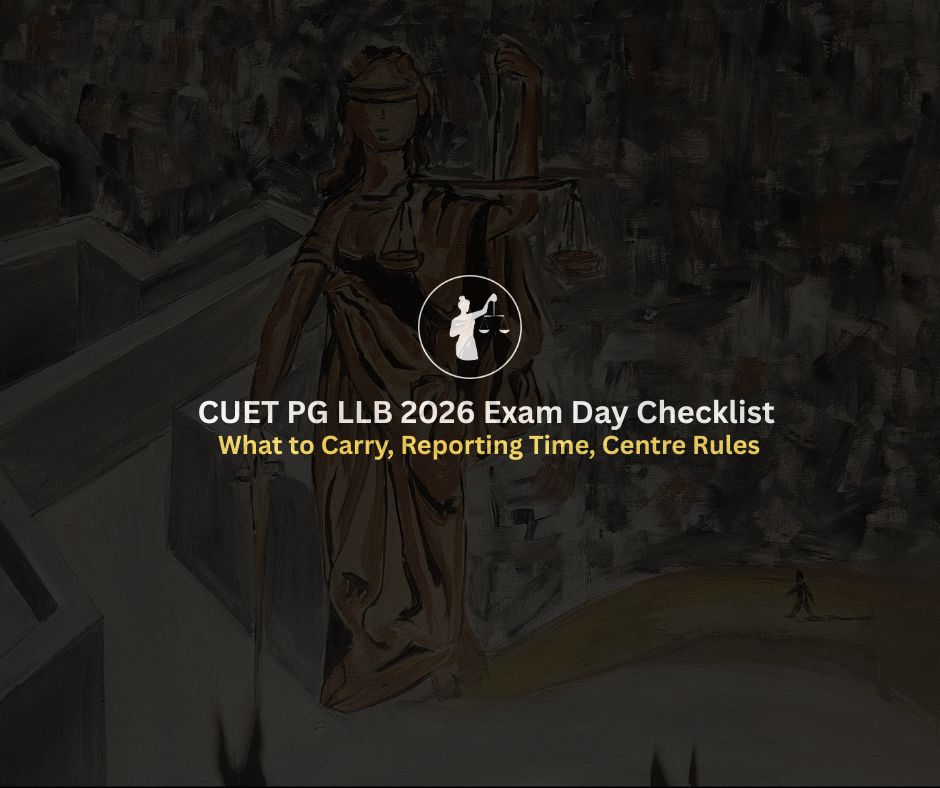The Common Law Admission Test (CLAT) is a national-level entrance exam conducted for admissions to undergraduate (UG) and postgraduate (PG) law programs offered by 22 National Law Universities (NLUs) across India. It is one of the most prestigious and competitive law entrance exams, with thousands of aspirants appearing every year to secure a seat in their dream law school.
( Note: Scroll Down and fill up the form for Free Mock Questions and Weekly Study Guides )
This step-by-step guide is specifically designed for beginners preparing for CLAT 2026. Whether you're a high school student planning your preparation journey early or someone looking to balance CLAT preparation with board exams, this guide will walk you through everything you need to know to excel in CLAT 2026.
Also Read: CLAT Syllabus 2026: Subject-Wise Breakdown & Important Tips
Before diving into preparation, it's crucial to thoroughly understand the CLAT 2026 exam pattern and syllabus. Having a clear idea of the structure will help you create a focused and effective study plan.
The CLAT 2026 exam tests candidates across five major sections, covering a wide range of topics to assess their comprehension, reasoning, analytical, and mathematical skills.
Signup to NLTI for free Mockups, past papers and much more
English Language
(28-32 questions; ~20% of the paper)
Current Affairs, including General Knowledge
(35-39 questions; ~25% of the paper)
Legal Reasoning
(35-39 questions; ~25% of the paper)
Logical Reasoning
(28-32 questions; ~20% of the paper)
Quantitative Techniques
(13-17 questions; ~10% of the paper)
This section tests your comprehension skills, grammar, and vocabulary. Passages of about 450 words are given, followed by multiple-choice questions.
Reading Comprehension:
Understanding the central theme, tone, and arguments.
Vocabulary:
Synonyms, antonyms, meanings of words in context.
Grammar & Usage:
Correction of sentences, identification of grammatical errors.
This section tests your awareness of current events and static general knowledge.
Current Affairs:
National and international events, awards, sports, legal developments.
Static GK:
History, Geography, Polity, Economics, Science, Art & Culture.
Designed to assess your legal aptitude and analytical abilities. Passages focus on legal principles, facts, and their application.
Legal Principles & Facts:
Application-based questions.
Legal Reasoning:
Understanding and analyzing rules and principles.
General Awareness of Legal Issues:
Recent legal developments, landmark judgments.
This section tests your critical thinking and analytical skills. It involves short passages followed by logical questions.
Critical Reasoning:
Assumptions, arguments, conclusions, strengthening/weakening arguments.
Analytical Reasoning:
Series, puzzles, analogies, syllogisms.
This section involves math-based questions derived from passages, graphs, or other diagrammatic representations.
Mathematical Concepts:
Ratios, percentages, algebra, time & work, profit & loss.
Data Interpretation:
Graphs, charts, tables, and other graphical formats.
Understanding the CLAT 2026 exam pattern and syllabus is the first and most crucial step towards effective preparation. By breaking down the exam into sections and understanding what each section demands, you can create a tailored study plan that suits your strengths and weaknesses.
Also Read: CLAT 2026 Exam Pattern Explained
Creating a well-structured study plan for CLAT 2026 is essential to cover the syllabus thoroughly and improve your performance over time. Whether you're a high school student juggling schoolwork or a college student managing multiple subjects, a practical and realistic study plan can make all the difference.
How to Make a Study Schedule That Fits Your Routine
To crack CLAT 2026, consistency matters more than long, stressful study hours. Here's how to create a practical schedule:
Analyze Your Daily Routine:
Identify free hours outside school, college, or other commitments.
Break your day into morning, afternoon, and evening slots to fit study sessions effectively.
Prioritize Based on Strengths & Weaknesses:
Allocate more time to challenging sections.
Example: If you're weak in Quantitative Techniques, dedicate extra hours to math practice.
Divide Your Study Time:
Weekdays: Study for 2-3 hours daily if you have school/college.
Weekends/Holidays: Increase study time to 4-5 hours for intensive preparation.
Use the Pomodoro Technique:
Study in 25-30-minute focused sessions, followed by a 5-minute break.
After 4 sessions, take a longer break of 20-30 minutes.
Setting Daily, Weekly, and Monthly Goals for Each Section
Breaking your CLAT 2026 preparation into small, achievable goals helps you stay motivated and track your progress effectively.
Here's how you can set goals:
Daily Goals:
Study at least two sections per day (e.g., English and Logical Reasoning).
Read newspapers for Current Affairs for a minimum of 30 minutes.
Practice 20-30 MCQs from previous year papers.
Weekly Goals:
Thoroughly cover 1-2 topics from each section.
Take one full-length mock test and carefully analyze your mistakes.
Revise vocabulary words and legal concepts covered during the week.
Monthly Goals:
Complete the syllabus for at least one section (e.g., Legal Reasoning).
Attempt 3-4 full-length mock tests and evaluate your progress.
Revise all the important notes and highlighted topics you've covered.
Setting realistic and structured goals will keep your CLAT preparation on track and improve your confidence as you progress.
Also Read: How to Prepare for CLAT 2026 in 6 Months
Many aspirants preparing for CLAT 2026 also have to manage their school or college studies. Here’s how to strike the right balance:
Prioritize Time Management:
Dedicate mornings or evenings to CLAT preparation if your school/college occupies most of your day.
Utilize breaks between classes or commute time to revise notes or read newspapers.
Create a Hybrid Study Schedule:
Divide your day into two slots: One for school/college subjects and the other for CLAT preparation.
For example, dedicate mornings to school studies and evenings to CLAT preparation.
Integrate CLAT Preparation with School/College Subjects:
English and General Knowledge preparation can be integrated with your regular studies.
Reading comprehension and vocabulary-building can enhance your English proficiency for school exams as well.
To prepare effectively for CLAT 2026, it’s crucial to gather the right study materials. Using standard books, online resources, and previous years’ papers will ensure you cover the syllabus comprehensively and develop strong conceptual clarity.
Having the right set of books makes all the difference in structured preparation. Here are some of the best books for CLAT 2026:
English Language:
Objective General English by R.S. Aggarwal (Comprehension and Practice)
Current Affairs (General Knowledge):
Newspapers: The Hindu, The Indian Express (Daily Reading)
Legal Reasoning:
Universal’s CLAT Guide (Complete Reference Book)
Logical Reasoning:
A Modern Approach to Logical Reasoning by R.S. Aggarwal
Quantitative Techniques:
NCERT Mathematics Books (Class 6 to 10) for building strong fundamentals.
Also Read: Most Common Myths About CLAT 2026
English Language (CLAT 2026):
Improve reading comprehension through regular practice of passages from newspapers and books.
Build vocabulary using Word Power Made Easy by Norman Lewis and daily word lists.
Current Affairs & General Knowledge (CLAT 2026):
Read newspapers daily for updates on national and international events.
Refer to monthly current affairs compilations like Pratiyogita Darpan.
Legal Reasoning (CLAT 2026):
Understand legal principles and their application in real-life scenarios.
Practice case-based questions from Universal’s CLAT Guide and Legal Awareness and Legal Reasoning by A.P. Bhardwaj.
Logical Reasoning (CLAT 2026):
Develop critical reasoning and analytical skills through regular practice.
Focus on puzzles, seating arrangements, syllogisms, and analogy-based questions.
Quantitative Techniques (CLAT 2026):
Build a strong foundation in basic mathematics (NCERT Class 6 to 10).
Practice arithmetic, algebra, geometry, and data interpretation questions.
Creating Revision Notes for Quick Reference:
Prepare concise notes for each section, focusing on important concepts, formulas, and vocabulary.
Highlight critical points for each topic to simplify last-minute revision.
Importance of Revising Weak Areas Consistently:
Identify weak areas through mock tests and practice papers.
Allocate extra time to strengthen topics where you face difficulties.
Setting a Revision Schedule for the Last 30 Days Before CLAT 2026:
Break down your revision plan into weekly and daily targets.
Dedicate the first 20 days to revising all sections thoroughly.
Spend the last 10 days focusing on weaker areas, mock tests, and previous years’ papers.
Preparing for CLAT 2026 may seem challenging, especially if you're a beginner.
However, with a well-structured study plan, the right resources, and consistent practice, you can excel in the exam..
Ready to take your CLAT 2026 preparation to the next level?
Join our CLAT Online Coaching & Mentorship Program for expert guidance, comprehensive study material, and personalized mentorship. Start your journey towards success today.





